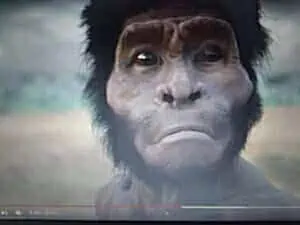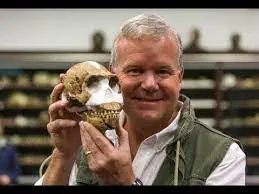Homo naledi “very primitive… small brained… these are features we see in the Australopiths”
 The discovery of Homo naledi in South Africa in 2013 is regarded by the Smithsonian Institute as on of the “The Top Ten Scientific Discoveries of the Decade.”
The discovery of Homo naledi in South Africa in 2013 is regarded by the Smithsonian Institute as on of the “The Top Ten Scientific Discoveries of the Decade.”
The human family tree expanded significantly in the past decade, with fossils of new hominin species discovered in Africa…
discovered in South Africa by a team led by [Lee] Berger, Homo naledi lived much more recently, some 335,000 to 236,000 years ago, meaning it may have overlapped with our own species, Homo sapiens. The species, first discovered in the Rising Star Cave system in 2013 and described in 2015, also had a mix of primitive and modern features, such as a small brain case…
A further description by Dr. Berger, along with his close friend Dr. John Hawks of the University of Wisconsin, Dr. Steven Churchill, cave explorer Dr. Marina Elliot of Canada and a multitude of fellow researchers. Published, 2015, elifesciences.org:
Homo naledi, a new species of the genus Homo from the Dinaledi Chamber, South Africa
 Homo naledi is a previously-unknown species of extinct hominin discovered within the Dinaledi Chamber of the Rising Star cave system, Cradle of Humankind, South Africa. This species is characterized by body mass and stature similar to small-bodied human populations but a small endocranial volume similar to australopiths. Cranial morphology of H. naledi is unique, but most similar to early Homo species including Homo erectus, Homo habilis or Homo rudolfensis.
Homo naledi is a previously-unknown species of extinct hominin discovered within the Dinaledi Chamber of the Rising Star cave system, Cradle of Humankind, South Africa. This species is characterized by body mass and stature similar to small-bodied human populations but a small endocranial volume similar to australopiths. Cranial morphology of H. naledi is unique, but most similar to early Homo species including Homo erectus, Homo habilis or Homo rudolfensis.
Representing at least 15 individuals with most skeletal elements repeated multiple times, this is the largest assemblage of a single species of hominins yet discovered in Africa.
Professor Churchill was recently interviewed by The Dissenter hosted by Ricardo Lopez The Dissenter covers topics such as science, medicine and psychology. From Steven Churchill’s bio at CARTA:
Steven Churchill is a Professor and past Chair of the Department of Evolutionary Anthropology at Duke University. He is also an Honorary Reader in the Evolutionary Studies Institute and Centre for *Excellence in PalaeoSciences at the University of the Witwatersrand. Dr. Churchill received a B.S. from Virginia Tech and an M.A. and Ph.D. from the University of New Mexico before joining the faculty at Duke in 1995. He is a paleontologist who studies the fossil record of human evolution, especially that of early members of our genus (Homo) that lived between about two million to ten thousand years ago.
*Note – Univ. of Witwatersrand in Johannesburg, South Africa is where Churchill’s friend Dr. Lee Berger is the head of the Dept. of Evolutionary Biology.
During the interview, Churchill made some startling remarks, which seemed to surprise even the host. A number of paleo-anthropologists including Berger and Hawks, have hinted around the identity of the mysterious ghost species admixture for modern Africans. But Prof. Churchill is the first to break protocol and say out loud, that it’s likely Homo naledi.
See our previous articles here at Subspecieist,
Africans have 19% archaic ghost species DNA according to New UCLA genetics paper
Excerpts from The Dissenter, Episode #635, “Steven Churchill: Homo naledi, Australopithecus sediba, and Human Evolution” June 30).
At the 16 minute mark Ricardo Lopes asks Dr. Churchill about Homo naledi, “where was it discovered… how does it relate to other species…”
Dr. Churchill describes in detail how recreational cave explorers Rick Hunter and Steven Tucker found the fossils in an isolated chamber of the Rising Star cave system.
 They were at the top of a feature called Dragon’s back, in a narrow little fissure… And Rick wanted to get a photo… and Steve noticed there was a small fissure to his side, so he squeezed into it. And once he squeezed into it, he realized it continued downwards… so he and Rick squeezed themselves down… and they found themselves in a chamber, and they saw bones. They took photographs, took them out, and that’s how Homo naledi was discovered.
They were at the top of a feature called Dragon’s back, in a narrow little fissure… And Rick wanted to get a photo… and Steve noticed there was a small fissure to his side, so he squeezed into it. And once he squeezed into it, he realized it continued downwards… so he and Rick squeezed themselves down… and they found themselves in a chamber, and they saw bones. They took photographs, took them out, and that’s how Homo naledi was discovered.
The cave explorers along with team leader Pedro Boshoff took the photos to Berger at his home, late that night. Berger immediately contacted National Geographic. A massive expedition was then undertaken by Berger and a team of 40 paleo-anthropologists, which is still ongoing today.
Homo naledi: “It has a brain about the size of a Gorilla’s brain”
Ricardo: And by now it’s accepted as a new anthropological species.
Dr. Churchill: I think most of the field accepts that it is a news species and that we were right to name it a new species. There are still some however, who contend that we have just found a more primitive form of Homo erectus. And that this should be called Homo erectus.
Ricardo: What is the time frame we’re talking about when it comes to Homo naledi?
Dr. Churchill: Well, this is the interesting thing. If you look at its anatomy it is very primitive. It has a small brain. 550 cubic centimeters. The average for Homo erectus is about 900 cubic centimeters. So, it has a brain about the size of a Gorilla’s brain. It’s relatively small-bodied. There are aspects of its body that are very primitive… these are features that we see in the Australopiths. A little ape man if you will…
Note – Average overall modern human brain size is 1,350cc. – Science Direct
African-descended people (Blacks) average cranial capacities of 1267 cm, European-descended people (Whites) 1347 cm, and East Asian-descended people (East Asians) 1364 cm…
Continuing:
 Dr. Churchill: When we were finally able to date some of the sentiments in the cave, we were shocked. Because it came out to be somewhere between 330 and 250,000 years ago… Out own species Homo sapiens had emerged by that time.
Dr. Churchill: When we were finally able to date some of the sentiments in the cave, we were shocked. Because it came out to be somewhere between 330 and 250,000 years ago… Out own species Homo sapiens had emerged by that time.
Ricardo: Oh, really?
Dr. Churchill: Yes! So, roughly a quarter of a million years ago, our own species, Homo sapiens, had emerged. By that time…
Ricardo: Yeah, oh yeah, that’s why I was surprised to learn, to know that. Because our species appeared around 100 to 300,000 years ago.
Dr. Churchill: Yes. So here are the interesting, some of the interesting things about Homo naledi, and this is the beautiful thing about paleo-anthropology. We’re discovering new things all the time. And those things are causing us to sort of rethink some of the long held ideas in the field…
“a work that’s been done on the genome of people who are indigenous to Africa… [to] identify what they call a ghost lineage which contributed genetically to our lineage. That could be Naledi…” — Prof. Churchill
Ricardo: So, could that have any implications for the timeline of our own species and its ancestors.
Dr. Churchill: I think that the most plausible explanation for Homo naledi is that it is a species that split off from other lineages from the genus Homo very early in time. Possibly before the emergence of Homo erectus… and for some reason it remains, well, morphologically primitive. Throughout time. It lives to about 250,000 years or so. So, in that respect people will refer to it as a relic species. A species that diverged early and didn’t change very much over time. But, during that existence it interbred with other members of the genus Homo, including perhaps our species, or ancestors of our species.
And what’s interesting is a work that’s been done on the genome of people who are indigenous to Africa, well, umm, I guess we’re all indigenous to Africa, but to Sub-saharan Africans, identify what they call a ghost lineage which contributed genetically to our lineage. That could be Naledi, or it could be that there are a lot of other things out there that are like Naledi, we just have never discovered them.


